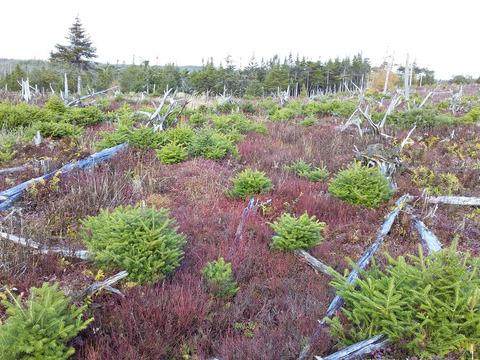当前位置:
X-MOL 学术
›
Funct. Ecol.
›
论文详情
Our official English website, www.x-mol.net, welcomes your
feedback! (Note: you will need to create a separate account there.)
Cumulative effects of spruce budworm and moose herbivory on boreal forest ecosystems
Functional Ecology ( IF 4.6 ) Pub Date : 2021-04-19 , DOI: 10.1111/1365-2435.13805 Shawn J. Leroux 1 , Louis Charron 1 , Luise Hermanutz 1 , Janet Feltham 2
中文翻译:

云杉幼虫和驼鹿食草对北方森林生态系统的累积影响
更新日期:2021-04-19
Functional Ecology ( IF 4.6 ) Pub Date : 2021-04-19 , DOI: 10.1111/1365-2435.13805 Shawn J. Leroux 1 , Louis Charron 1 , Luise Hermanutz 1 , Janet Feltham 2
Affiliation

|
- Ungulate herbivory is a key natural disturbance in many ecosystems. In forest ecosystems, ungulate herbivory often co-occurs with other disturbances yet there are few studies looking at the cumulative impacts of ungulates and other natural disturbances on forest dynamics.
- We report on an 18-year experiment to investigate the combined effects of introduced, non-native moose and native spruce budworm herbivory on balsam fir forest recruitment and regeneration. Specifically, we measured inputs into early life-history components of balsam fir dominant boreal forest ecosystems such as seed density, seedbed quality, seedling and sapling height and density, as well as adult density in eight paired moose exclosure and control sites across a spruce budworm disturbance gradient (i.e. no outbreak, recent outbreak, old outbreak) that resulted in closed, partially open and open canopies.
- Piecewise structural equation models (SEMs) revealed a strong negative effect of spruce budworm disturbance on balsam fir adult density and indirect effects of this budworm disturbance on balsam fir seedling and sapling density mediated through adult density. We observed a similar pattern of budworm disturbance effects on balsam fir seed density with the lowest densities in sites with open canopy, then partially open and closed canopies. As expected, the SEM showed a positive effect of bryophyte seedbed cover on balsam fir seedling density. The SEM showed support for a positive effect of moose exclusion on balsam fir sapling height and density. Specifically, saplings were on average taller and denser in exclosure than control plots and these differences are most pronounced at sites with partially open canopies created by spruce budworm disturbance and undisturbed or closed canopy sites. Overall, we show evidence for cumulative and interactive effects of spruce budworm and moose herbivory on all life stages of balsam fir and such effects are negatively affecting regeneration of balsam fir forests.
- Human activities are creating conditions that facilitate the expansion and increased impacts of herbivores on boreal ecosystem functioning. A greater understanding of how ungulate herbivory interacts with other disturbances is needed to improve our predictions of forest ecosystem dynamics under global change.
中文翻译:

云杉幼虫和驼鹿食草对北方森林生态系统的累积影响
- 有蹄类食草动物是许多生态系统中的主要自然干扰。在森林生态系统中,有蹄类食草动物经常与其他干扰同时发生,但很少有研究关注有蹄类动物和其他自然干扰对森林动态的累积影响。
- 我们报告了一项为期 18 年的实验,以研究引入的非本地驼鹿和本地云杉 budworm 食草动物对香脂冷杉森林补充和再生的综合影响。具体来说,我们测量了对香脂冷杉占优势的北方森林生态系统早期生活史组成部分的输入,例如种子密度、苗床质量、幼苗和树苗高度和密度,以及 8 个成对的驼鹿围栏和控制地点的成虫密度。干扰梯度(即没有爆发、最近爆发、旧爆发)导致封闭、部分开放和开放的檐篷。
- 分段结构方程模型 (SEMs) 揭示了云杉 budworm 干扰对香脂冷杉成虫密度的强烈负面影响,以及这种芽虫干扰对通过成虫密度介导的香脂冷杉幼苗和树苗密度的间接影响。我们观察到类似的 budworm 干扰对香脂冷杉种子密度的影响模式,在有开放树冠的地点密度最低,然后是部分开放和关闭的树冠。正如预期的那样,SEM 显示苔藓植物苗床覆盖对香脂冷杉幼苗密度有积极影响。SEM 显示支持排除驼鹿对香脂冷杉树苗高度和密度的积极影响。具体来说,平均而言,围护区中的树苗比对照地块更高、更密,这些差异在云杉 budworm 干扰造成的部分开放冠层和未受干扰或封闭的冠层站点上最为明显。总体而言,我们展示了云杉 budworm 和驼鹿食草对香脂冷杉所有生命阶段的累积和交互影响的证据,这些影响对香脂冷杉林的再生产生了负面影响。
- 人类活动正在创造条件,促进食草动物对北方生态系统功能的影响和扩大。需要更深入地了解有蹄类食草动物如何与其他干扰相互作用,以改善我们对全球变化下森林生态系统动态的预测。











































 京公网安备 11010802027423号
京公网安备 11010802027423号